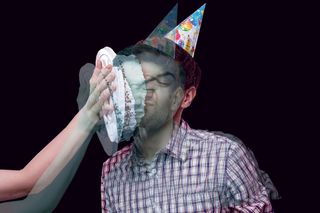
How Did Violent Birthday Bumps Become a Celebratory Tradition?
Violent birthday customs were meant to bring good luck; now they just feel violent.

Indian birthdays, at least when I was growing up, always went a certain way: you would have friends over; your family would serve up different renditions of chips and pav bhaji; there’d be games that mostly involved pointless running; the cake cutting would be a sordid affair, with manic friends launching fistfuls of cake all over your face.
And at some point in the evening, you’d have to brace yourself for some jolting, body-flinging birthday bumps.
There was always immense glee among the celebratory abusers and an inherent discomfort for the birthday person. How did such birthday punches and spankings come to be so normalized that we don’t even bat an eye while pummelling some poor chap to the ground?
Called ‘birthday bumps,’ the ceremonial hitting is not a phenomenon unique to India. In the U.K., Ireland, and Canada, itinvolves taking the birthday person by their arms and legs and flinging them up and down in the air. A common explanation of the practice is an attempt to mimic the way we fling infants into the air to make them giggle. As someone who was ‘flung’ well into her teenage years, I can tell you — weight is not a deterrent here. Other methods of ‘birthday bumps’ are kicks, punches, and spanks. For the latter, the practice is believed to date back to the first ‘birthday bump’ a child ever receives — from a doctor or nurse — when they are spanked to get their blood moving and incite their first cry. The number of bumps accorded to a person typically corresponds to how old they’re turning. While birthday rituals vary across different regions of the world, a common theme that runs through them is a physical violation of personal space, or violence, justified as a means of preserving the birthday person’s luck or good fortune.
In New Delhi, for 700 years, a Muslim shrine has dropped babies from the roof during birthday celebrations. The fall is ironically meant to ensure good health for the baby. While the baby is caught in a taut bedsheet before hitting the ground, the risk a newborn is put through for the sake of a birthday ritual is undeniable. In Jamaica, a birthday tradition called ‘flouring’ involves coming up with sneaky ways to throw flour on the birthday person.
Related on The Swaddle:
The Science Behind Typical Teenage Behavior
While these traditions have been universally acknowledged as harmless ways of celebrating birthdays, Indian authorities have cracked down on them recently.
In 2013, IIT-Bombay banned the practice of giving ‘birthday bumps’ on campus, deeming the tradition equivalent to ragging. At the time, the Times of India reported students meting out spanks with belts and slippers and quoted UA Yajnik, the dean of student affairs at IIT-Bombay, as saying, “Students often get carried away while giving birthday bumps, and it might result in an accident, and there is a fear of spinal injury. Moreover, no student wants to come forth and report these incidents. [To] avoid such untoward accidents, we believe that banning such activities is ideal.”
Most recently in May, the city of Surat in Gujarat banned the smearing of cake on faces or giving ‘birthday bumps’ in public, prohibiting “cruel and violent” birthday traditions. Surat’s Commissioner of Police, Satish Sharma, issued a notification banning such celebrations in public spaces like parks and on roads and bridges. Those in violation of the order will now risk an arrest. “In the name of birthday celebrations at public places, these students forcibly apply sticky tapes, chemicals or foam on others. They even beat up each other during such celebrations. It is possible that someone [dies] or public property [gets] damaged due to such [a] cruel and violent way of celebration,” according to the order.
Violent birthday celebrations are also gendered, says psychologist Pallavi Bhurkay. “Growing up is about becoming a man — more strong, more macho. Friends usually embarrass you, which is a kind of emotional bashing,” she says. “Girls are allowed to cry, while boys are allowed to be angry and aggressive.” The physical bashing in ‘birthday bumps’ is often a way to test the physical and emotional vulnerability of the person, Bhurkay added. “We all have low self-worth; it is especially apparent in teenagers. When they suffer from low self-worth, they feel ‘I have to prove I can take this shit you’re giving me. I will take it at the cost of my pain, because if I say no, I will look like a sissy’,” she said, adding the need to tolerate and maintain birthday traditions often stems from boys’ need to prove they are strong and tolerant.
“The whole idea is that — I am going to be abused, it is okay to be macho. They will do the same thing to their children. They will believe that it is okay to be abused, and it’s okay to abuse someone else.”
As someone who detested ‘birthday bumps’, and would look for places to hide so my friends wouldn’t ‘get’ me for the ceremonial hitting, I’m baffled more people don’t question this age-old tradition. Sure, traditions usually serve to foster feelings of community and kinship, but only if everybody involved likes them. So, who, or what, are we really celebrating? If birthdays are supposed to be about celebrating the person involved, and the person dreads ‘birthday bumps’ — which, let’s be honest, everyone dreads it — then we’re really just celebrating an excuse to be a little bit mean, a little bit abusive, no?
Rajvi Desai is The Swaddle's Culture Editor. After graduating from NYU as a Journalism and Politics major, she covered breaking news and politics in New York City, and dabbled in design and entertainment journalism. Back in the homeland, she's interested in tackling beauty, sports, politics and human rights in her gender-focused writing, while also co-managing The Swaddle Team's podcast, Respectfully Disagree.
Related


The Swaddle Team Sounds Off on ‘Kabir Singh’ and Misogyny in Film
